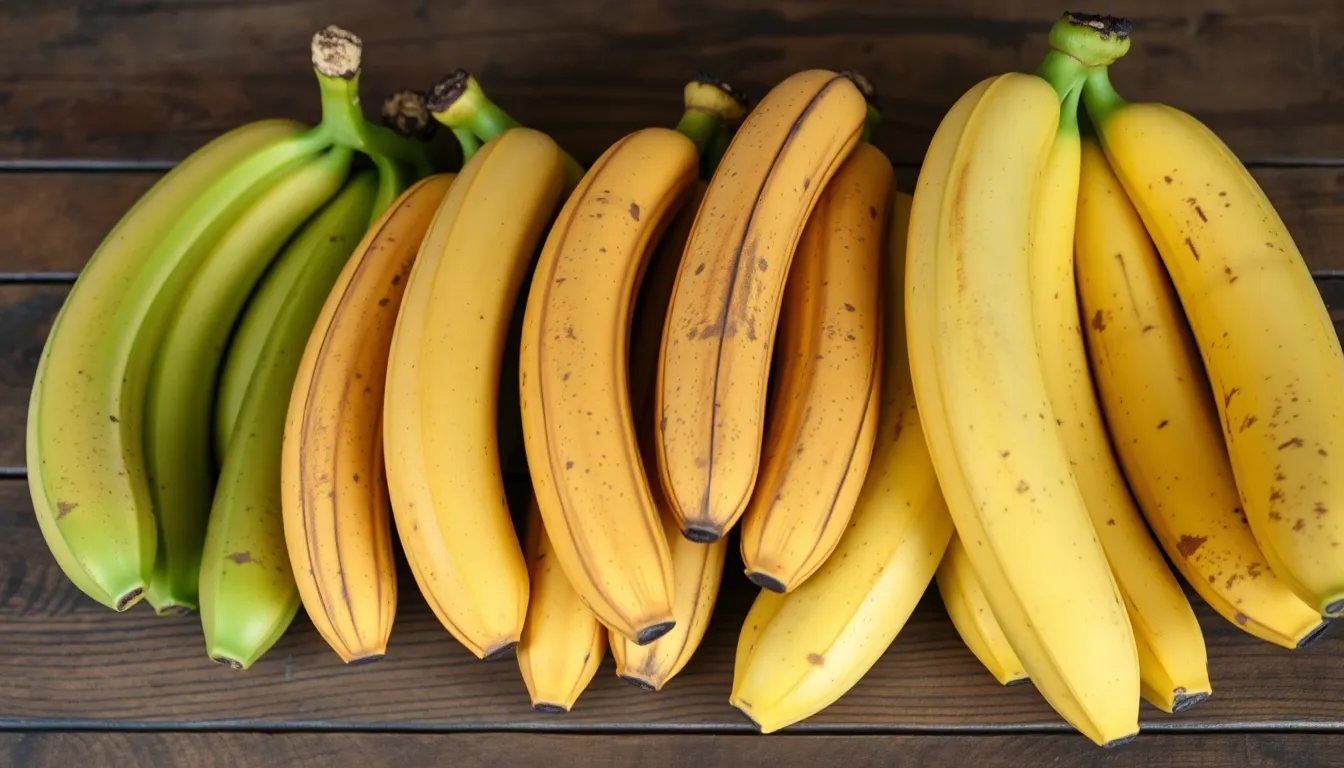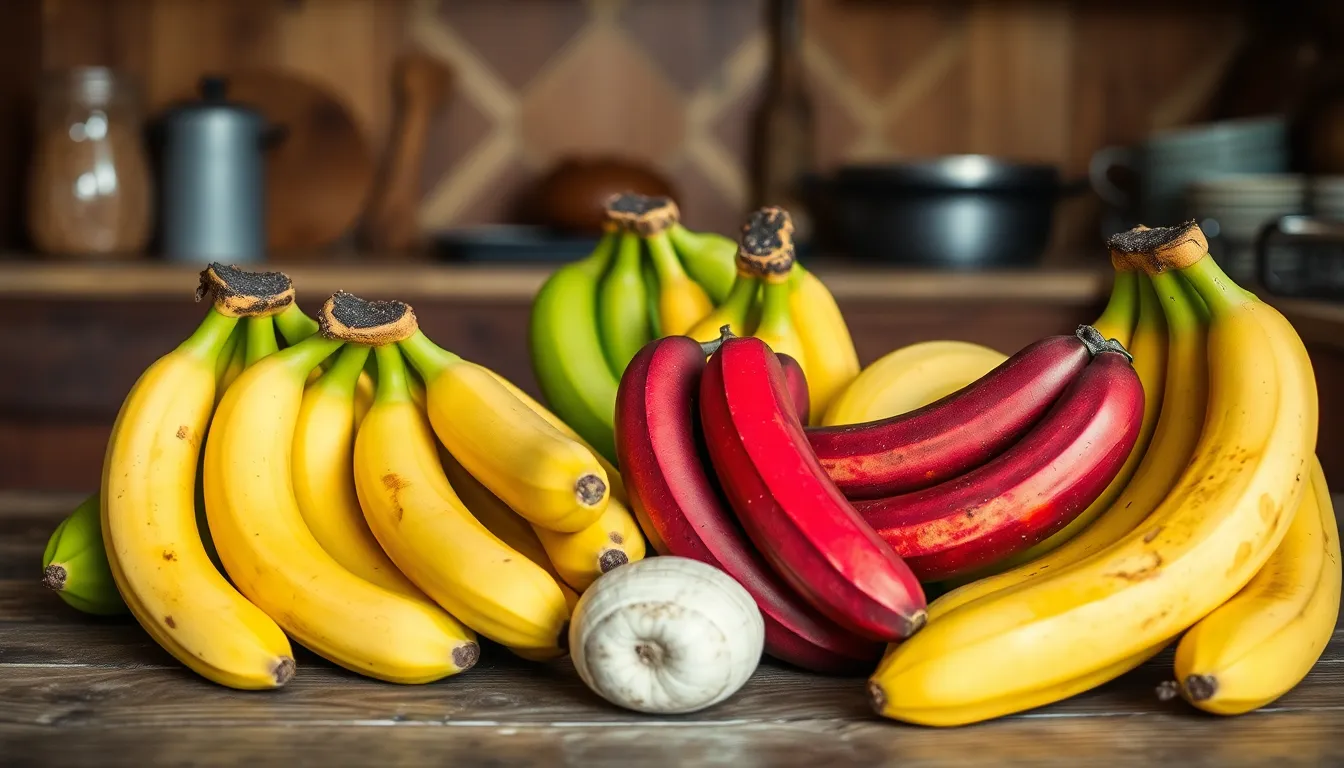Bananas are the ultimate snack: portable, tasty, and packed with nutrients. But how often do people stop to think about what real bananas actually look like? Spoiler alert: they’re not always the perfect yellow fruit you see in the grocery store. In fact, the bananas we know and love have undergone quite the makeover over the years, and the truth might just surprise you.
Table of Contents
ToggleWhat Do Real Bananas Look Like: An Overview
Real bananas differ significantly from the standard yellow variety found in stores. Various species of bananas exist, each showcasing unique characteristics. For instance, the original wild bananas, scientifically known as Musa acuminata, typically display multiple seeds within their flesh. These seeds contribute to a grainy texture, unlike the smooth, seedless bananas commonly consumed.
Wild bananas often exhibit an array of colors, including green, brown, and even maroon. Additionally, their size varies considerably; some wild varieties can be much larger than the cultivated Cavendish bananas. Color and size contribute to the distinct visual appeal of real bananas.
Shape also plays a vital role in banana diversity. Most cultivated bananas present a curved shape, yet wild varieties can appear straighter, reflecting their ecological adaptations. These adaptations help the plant thrive in natural habitats, illustrating a connection between banana morphology and environmental factors.
Flavor profiles of real bananas vary widely. Some wild varieties possess a sweeter or more tart taste, contributing to their culinary versatility. Different textures, such as soft or firmer ones, also characterize various species.
Real bananas demonstrate a captivating range of colors, sizes, shapes, and tastes. This diversity highlights the differences between the cultivated bananas typically seen in grocery stores and the original species that once grew in the wild. Understanding these attributes reveals the fascinating world of bananas beyond the familiar yellow fruit.
Physical Characteristics of Real Bananas

Real bananas exhibit a striking variety of physical characteristics, showcasing their rich diversity compared to common cultivated types.
Color Variations
Color variations in bananas range widely beyond the familiar yellow. Wild bananas may display hues of green, brown, or maroon, depending on the specific species and ripeness. The Musa acuminata exhibits a vibrant appearance, with some varieties featuring a mottled skin that adds to their unique allure. Others may start off green and transition to deeper shades when ripe, highlighting an interesting visual journey. These colors signal ripeness and flavor potential, inviting exploration of different culinary experiences.
Size and Shape
Size and shape of real bananas diverge significantly from standard grocery store varieties. Wild bananas can reach sizes larger than cultivated Cavendish counterparts, with some measuring up to 12 inches long. Shapes also vary; while most cultivated bananas curve gently, wild types often appear straighter or more angular. This diversity in shape contributes to a variety of textures and flavors, enhancing their appeal in culinary uses. Notably, their differing dimensions and forms illustrate the broader spectrum of banana species, emphasizing the fascinating attributes of real bananas.
Types of Real Bananas
Real bananas come in various types, each exhibiting unique characteristics and flavors. These bananas stand out from the common varieties typically found in stores.
Cavendish Bananas
Cavendish bananas dominate global markets, representing the most commonly consumed type. Initially cultivated in Southeast Asia, these bananas feature yellow skin when ripe. Their size generally ranges from 6 to 8 inches long and has a distinct curved shape. The texture is smooth, with a mild, sweet flavor. A significant factor in their popularity is their resistance to shipping and handling, which makes them suitable for export. Cultivation focuses on uniformity, which results in their consistent taste and appearance.
Red Bananas
Red bananas present a striking alternative, characterized by their reddish-purple skin. This variety typically measures between 6 to 7 inches in length and has a unique, sweeter flavor compared to the Cavendish. Upon ripening, the skin transforms to a deeper hue, signaling their readiness for consumption. The creamy flesh features a slight raspberry-like taste, adding variety to dishes. Nutritionally, red bananas offer similar benefits to yellow ones, providing essential vitamins and minerals. Enhanced appeal in the culinary world stems from their vibrant color and taste.
The Journey from Plant to Fruit
The journey of a banana begins with the banana plant, which is technically classified as a herbaceous perennial rather than a tree. Bananas grow in clusters on large stalks, with each stalk producing multiple hands of fruit. Each individual fruit develops from a flower and takes about 75 to 80 days to mature, depending on the variety and environmental factors.
During the flowering stage, the banana plant produces large, purple flowers, which eventually give way to the fruit. Pollination typically occurs, but cultivated varieties like the Cavendish often develop without it. They grow in climates suitable for tropical plants, where temperatures remain warm and humidity levels are high.
Harvesting begins once the bananas reach the appropriate size and color, which varies among species. After cutting, bananas undergo a ripening process, usually assisted by ethylene gas. This process transforms green bananas into the bright yellow fruit familiar to consumers. Moving through the supply chain, bananas are stored in controlled environments to prolong their freshness until reaching grocery stores.
Wild bananas, unlike their cultivated counterparts, possess seeds, contributing to their differing appearances and textures. These seeds can contribute a grainy quality to the flesh. During this stage, growers often select varieties based on taste, nutritional value, and resistance to diseases and pests, developing strategies to cultivate robust species.
Culinary applications of bananas extend beyond sweet desserts into savory dishes. The unique flavors of real bananas enhance myriad recipes, encouraging chefs to explore their rich diversity. Understanding the journey from plant to fruit illustrates the complexities involved in banana production, revealing an intriguing story behind this beloved snack.
Nutritional Aspects of Real Bananas
Real bananas provide a wealth of nutrients essential to a balanced diet. They are rich in potassium, which supports heart health and regulates blood pressure. Fiber content in bananas enhances digestive health, promoting regular bowel movements and overall gut function.
Several vitamins contribute to their nutritional profile, including vitamin C and vitamin B6, both of which play key roles in immune function and energy metabolism. Additional antioxidants found in bananas help combat oxidative stress, protecting cells from damage.
While the Cavendish variety is commonly recognized, other wild bananas also offer substantial health benefits. Red bananas, for example, boast higher antioxidants than their yellow counterparts. Each type provides varying flavor and nutrition, allowing for dietary diversification.
Bananas generally contain low calories, making them an excellent snack choice. One medium-sized banana typically contains about 105 calories, alongside 27 grams of carbohydrates. The natural sugars in bananas, such as fructose and glucose, offer quick energy sources, ideal for athletes or those needing an energy boost.
Considering dietary guidelines, incorporating real bananas into meals can enhance nutritional intake. They serve well in smoothies, baked goods, or as standalone snacks. Their nutritional diversity and versatility make them a valuable addition to various culinary applications.
Real bananas offer a fascinating glimpse into the diversity of this beloved fruit. With their wide range of colors sizes and flavors they stand in stark contrast to the familiar yellow Cavendish variety. The exploration of wild bananas reveals their unique characteristics and culinary potential.
Whether it’s the sweeter taste of red bananas or the grainy texture of wild varieties these fruits are more than just a convenient snack. They’re a testament to nature’s variety and richness. By incorporating real bananas into meals and snacks individuals can enjoy not only their deliciousness but also their numerous health benefits. Embracing this diversity can elevate culinary experiences and showcase the true essence of what bananas can be.








